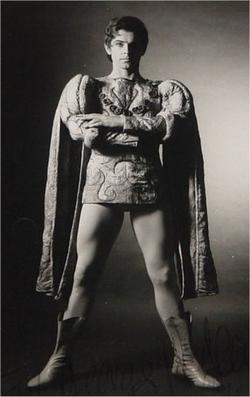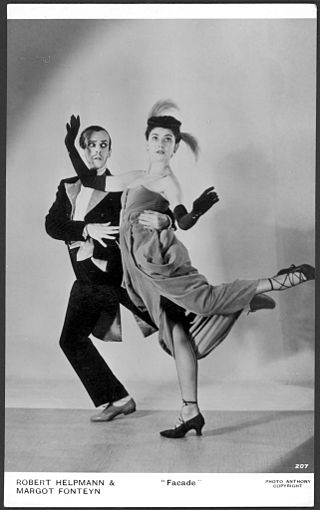Related Research Articles

Sadler's Wells Theatre is a London performing arts venue, located in Rosebery Avenue, Islington. The present-day theatre is the sixth on the site. Sadler's Wells grew out of a late 17th-century pleasure garden and was opened as a theatre building in the 1680s.
Linda Michelle Merrill, known professionally as Merrill Ashley, is an American former ballet dancer and répétiteur. She joined the New York City Ballet in 1967, was promoted to principal dancer in 1977, and retired in 1997. She is one of the last dancers to have worked with George Balanchine, and coaches his works since she stopped performing.
Maryon Lane was a South African ballet dancer who became well known in Britain as a ballerina of the Sadler's Wells Theatre Ballet and as a soloist with the Royal Ballet.
Impressing the Czar is a four-act, award-winning, postmodern ballet choreographed by William Forsythe to music by Thom Willems, Leslie Stuck, Eva Crossman-Hecht, and Ludwig van Beethoven. It was premiered in its full-length version in 1988 in Frankfurt am Main by the Ballet Frankfurt.
Nina Aleksandrovna Anisimova was a Soviet dancer and choreographer.
Les Patineurs is a ballet choreographed by Frederick Ashton to music composed by Giacomo Meyerbeer and arranged by Constant Lambert. With scenery and costumes designed by William Chappell, it was first presented by the Vic-Wells Ballet at the Sadler's Wells Theatre, London, on 16 February 1937. It has been called "a paradigm of an Ashton ballet, perfectly crafted with a complex structure beneath the effervescent surface."

Pearl Argyle was a South African ballet dancer and actress. She appeared in leading roles with English ballet companies in the 1930s and later performed in stage musicals and in films.

Derek Rencher was a British ballet dancer. A commanding figure among Royal Ballet character dancers for more than four decades, he was probably the most prolific performer in the company's history.

Façade is a ballet by Frederick Ashton, to the music of William Walton; it is a balletic interpretation of items from Façade – an Entertainment (1923) by Walton and Edith Sitwell. The ballet was first given by the Camargo Society at the Cambridge Theatre, on 26 April 1931. It has been regularly revived and restaged all over the world.
Sophie Fedorovitch was a Russian-born theatrical designer who worked with ballet choreographer Sir Frederick Ashton from his first choreographed ballet in 1926 until her accidental death in 1953.
Harold Turner was an English ballet dancer, teacher, and ballet master. Widely recognized as "modern British ballet's first male virtuoso," he had an illustrious career as a principal dancer, after which he continued to perform in character roles. He is acknowledged as a key figure in British dance history.
Desmond Doyle was a South African ballet dancer who performed in England in the 1950s and 1960s before becoming ballet master of The Royal Ballet.
Brian Shaw was a British ballet dancer and teacher. As a leading dancer with the Royal Ballet during the 1950s and 1960s, he was widely regarded as "one of the finest classical male dancers of his generation".

Hofesh Shechter is an Israeli choreographer, dancer and composer based in London. He is best known for being the founder and artistic director of the Hofesh Shechter Company.
Alfred Rodrigues was a South African ballet dancer and choreographer. His works have been produced by ballet and opera companies in many countries of the world.
Céline Gittens is a Trinidadian ballerina. She is a principal dancer at the Birmingham Royal Ballet, in Birmingham, England.
Mam'zelle Angot is a one-act ballet in three scenes. The choreography and libretto are by Léonide Massine; the music is by Charles Lecocq. The plot is broadly based on Lecocq's 1872 opéra bouffe, La fille de Madame Angot.
Corybantic Games is a ballet choreographed by Christopher Wheeldon to Bernstein's Serenade after Plato's "Symposium", with costumes designed by Erdem Moralıoğlu and sets designed by Jean-Marc Puissant. It premiered on 15 March 2018 at the Royal Opera House, danced by The Royal Ballet.
Five Brahms Waltzes in the Manner of Isadora Duncan is a ballet solo choreographed by Frederick Ashton to music by Johannes Brahms, inspired by Isadora Duncan and created for Lynn Seymour. The first version, under the title Brahms Waltz, used only Brahms' Op. 39, No. 15, and premiered on 22 June 1975, at the Hamburg State Opera. The expanded version, which featured more Brahms waltzes, premiered on 15 June 1976, during Ballet Rambert's 50th anniversary gala, at the Sadler's Wells Theatre, London, and is dedicated to Marie Rambert.
Nine Sinatra Songs is a ballet choreographed by Twyla Tharp to songs sung by Frank Sinatra. The ballet is danced by seven couples, portraying different stages of romantic relationships, with ballroom dancing incorporated into the choreography. The ballet was made for Twyla Tharp Dance, and premiered on October 14, 1982, at Queen Elizabeth Theatre, Vancouver, Canada.
References
- 1 2 3 Snider, Sarah Kirkland (2018). "Embrace". G. Schirmer Inc. Retrieved July 30, 2023.
- ↑ Anderson, Zo (June 18, 2018). "Polarity & Proximity, Sadler's Wells, London, review: Birmingham Royal Ballet dazzle their way through new and recent work". The Independent . Retrieved July 30, 2023.
- ↑ Craine, Debra (June 19, 2018). "Dance review: Birmingham Royal Ballet at Sadler's Wells". The Times . Retrieved July 30, 2023.
- ↑ Mackrell, Judith (June 18, 2018). "Birmingham Royal Ballet: Polarity and Proximity review – dialogues of desire". The Guardian . Retrieved July 30, 2023.